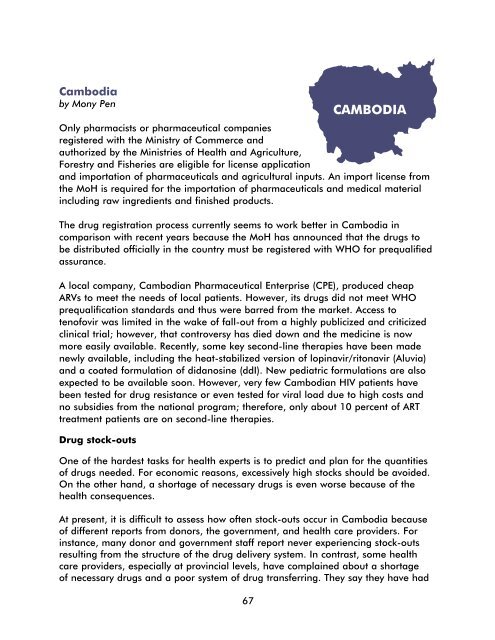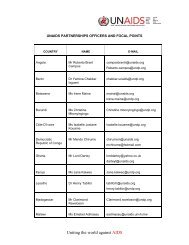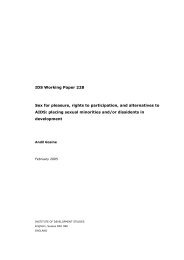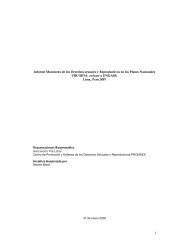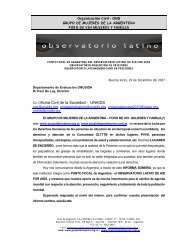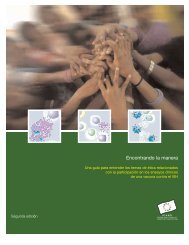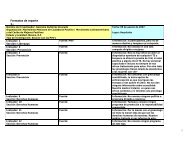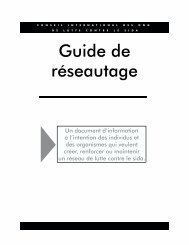Missing the Target #5: Improving AIDS Drug Access ... - CD8 T cells
Missing the Target #5: Improving AIDS Drug Access ... - CD8 T cells
Missing the Target #5: Improving AIDS Drug Access ... - CD8 T cells
You also want an ePaper? Increase the reach of your titles
YUMPU automatically turns print PDFs into web optimized ePapers that Google loves.
Cambodiaby Mony PenOnly pharmacists or pharmaceutical companiesregistered with <strong>the</strong> Ministry of Commerce andauthorized by <strong>the</strong> Ministries of Health and Agriculture,Forestry and Fisheries are eligible for license applicationand importation of pharmaceuticals and agricultural inputs. An import license from<strong>the</strong> MoH is required for <strong>the</strong> importation of pharmaceuticals and medical materialincluding raw ingredients and finished products.The drug registration process currently seems to work better in Cambodia incomparison with recent years because <strong>the</strong> MoH has announced that <strong>the</strong> drugs tobe distributed officially in <strong>the</strong> country must be registered with WHO for prequalifiedassurance.A local company, Cambodian Pharmaceutical Enterprise (CPE), produced cheapARVs to meet <strong>the</strong> needs of local patients. However, its drugs did not meet WHOprequalification standards and thus were barred from <strong>the</strong> market. <strong>Access</strong> totenofovir was limited in <strong>the</strong> wake of fall-out from a highly publicized and criticizedclinical trial; however, that controversy has died down and <strong>the</strong> medicine is nowmore easily available. Recently, some key second-line <strong>the</strong>rapies have been madenewly available, including <strong>the</strong> heat-stabilized version of lopinavir/ritonavir (Aluvia)and a coated formulation of didanosine (ddI). New pediatric formulations are alsoexpected to be available soon. However, very few Cambodian HIV patients havebeen tested for drug resistance or even tested for viral load due to high costs andno subsidies from <strong>the</strong> national program; <strong>the</strong>refore, only about 10 percent of ARTtreatment patients are on second-line <strong>the</strong>rapies.<strong>Drug</strong> stock-outsOne of <strong>the</strong> hardest tasks for health experts is to predict and plan for <strong>the</strong> quantitiesof drugs needed. For economic reasons, excessively high stocks should be avoided.On <strong>the</strong> o<strong>the</strong>r hand, a shortage of necessary drugs is even worse because of <strong>the</strong>health consequences.At present, it is difficult to assess how often stock-outs occur in Cambodia becauseof different reports from donors, <strong>the</strong> government, and health care providers. Forinstance, many donor and government staff report never experiencing stock-outsresulting from <strong>the</strong> structure of <strong>the</strong> drug delivery system. In contrast, some healthcare providers, especially at provincial levels, have complained about a shortageof necessary drugs and a poor system of drug transferring. They say <strong>the</strong>y have had67


